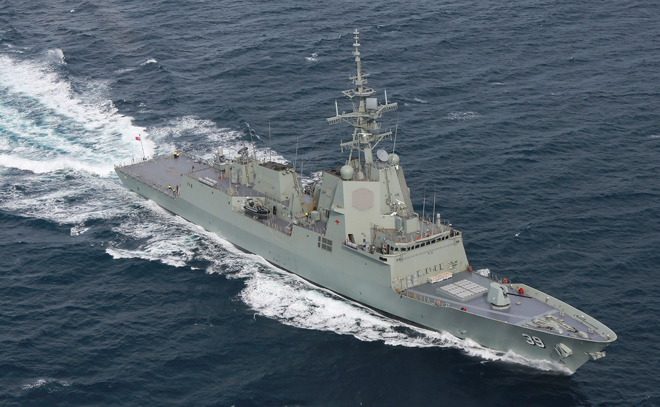
The Royal Australian Navy (RAN) commissioned the guided-missile destroyer HMAS Hobart in 2015. The Hobart is equipped with the Aegis combat system, incorporating the state-of-the-art AN/SPY 1D(V) phased-array radar. Australia plans to acquire a total of three Aegis-equipped ships for fleet air defense. Considering the security environment in the Asia-Pacific region, however, Australia should consider using its Aegis-equipped destroyers not only to enhance its domestic defense capabilities, but also to ensure the peace and security of the region by working side-by-side with its Ageis-equipped allies.
The RAN can both defend itself domestically and enhance regional security by conducting ballistic-missile surveillance and sharing its intelligence with the United States, Japan, and South Korea. Although the RAN does not have the capability to shoot down ballistic missiles, the AN/SPY 1D(V) radar on its Aegis-equipped ships can detect ballistic missiles from North Korea or China if properly stationed (though a software upgrade may be required).
There are three advantages for Australia in assisting with regional ballistic-missile defense:
First, regional ballistic-missile defense could enhance Australia’s security. In April 2017, North Korea threatened that Australia will be a target of nuclear attack. According to Japan’s annual defense white paper, northern Australia is within striking range of North Korea’s Taepodong-2 missile. All of Australia is in range of the Taepodong-3 variant. In addition, China’s DF-31s and DF-5s can reach Australia; and the South China Sea—key to Australia in securing its sea line of communications—is in the range of DF-31s, DF-5s, and DF-4s. Ballistic-missile defense can help Australia manage this threat.
Second, Australia’s participation in regional ballistic-missile defense will enhance deterrence. Currently, the United States, Japan, and South Korea cooperate on ballistic-missile defense in the Asia-Pacific region. At sea, the U.S. Navy and Japan Maritime Self-Defense Force (JMSDF) have kinetic ballistic-missile defense capability with the SM-3, and the South Korean Navy shares ballistic-missile-related intelligence. In 2016, the U.S. Navy, JMSDF, and South Korean Navy conducted a trilateral exercise called Pacific Dragon. Pacific Dragon enhanced not only ballistic-missile defense interoperability but also deterrence by showing a strong cooperating structure. If Australia were to cooperate on ballistic-missile defense, a wider area of the Asia-Pacific region would be covered; the Australian Navy’s participation in Pacific Dragon would establish a quadrilateral ballistic-missile defense structure and enhance threat deterrence.
Third, the RAN’s ballistic-missile defense capability will enable Australia to join integrated air missile defense (IAMD) in a more flexible manner. IAMD was proposed by the U.S. Joint Chiefs of Staff in 2013. According to “Joint Integrated Air and Missile Defense: Vision 2020,” the IAMD environment is characterized by a full range of air and missile threats—ballistic missiles, air-breathing threats, etc. The concept of IAMD is to have both wide-domain air defense and mass retaliation capability to establish global-level deterrence with the support of allies. If the RAN’s Aegis destroyers can deal with ballistic missiles without limiting their fleet air-defense capability, Australia can flexibly contribute and strengthen deterrence.
The RAN states in its defense white paper that Australia should “contribute military capabilities to coalition operations that support Australia’s interests in a rules-based global order” from both long and strategic points of view. Cooperating with the U.S., Japanese, and South Korean navies in Aegis ballistic-missile defense operations would be a good start.


